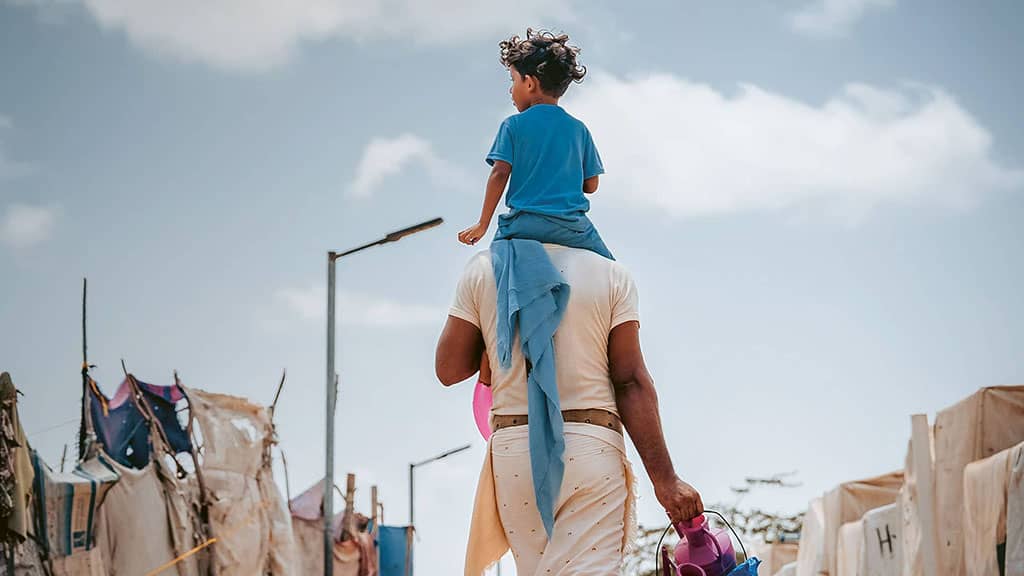
The GHI score of West Asia and North Africa, categorized as moderate, has stagnated, reflecting the overlapping effects of conflict, climate change, and trade shocks.
The region’s heavy reliance on food imports has made it especially vulnerable to recent global and regional trade shocks, which have caused rampant inflation, disrupted domestic food systems, and made nutritious diets less accessible and affordable. Political instability, fragility, natural disasters, and persistent conflicts contribute to large refugee populations and broader food insecurity; by the end of 2024, the region is projected to have 15.8 million forcibly displaced and stateless people (UNHCR 2024a).
Additionally, high vulnerability to climate change and water scarcity poses a long-term threat to the region’s food security (IFPRI 2024). The severe three-year drought that afflicted West Asia from 2020 was driven by climate change and compounded by socioeconomic stressors, severely impacting agriculture and access to potable water (Otto et al. 2023b).
Yemen’s hunger levels have stagnated for two decades, and Syria has seen the starkest increase in GHI scores since 2000 (Figure 1.3), reflecting the devastating impact of conflict. In Yemen, conflict-induced economic isolation and severe shortages of food, fuel, and medical supplies have had disastrous effects on undernourishment and child undernutrition. Undernourishment increased by more than 15 percentage points between 2000–2002 and 2021–2023. Almost half of Yemeni children—48.5 percent—are stunted, and 16.8 percent of children are wasted. In 2023, 18 million people, more than half of the population, faced an acute food crisis (FSIN and GNAFC 2024).
In Syria, prolonged conflict, coupled with increased impacts of natural hazards, has led nearly 13 million people to experience high levels of acute food insecurity (FSIN and GNAFC 2024). Undernourishment, now at 34.0 percent, increased by more than 20 percentage points between 2015–2017 and 2021–2023. The conflict, which has lasted for more than a decade, has severely disrupted agriculture and food value chains. Many farmers are unable to cultivate their total land due to limited access, unavailable or high-priced inputs, and lack of financial means, and many households are forced to seek low-wage, off-farm employment that barely meets their needs (Ibrahim et al. 2024).
Gaza is experiencing the most severe food crisis recorded in the past 20 years, as almost the entire population of Gaza is facing crisis levels of acute food insecurity, and famine might already be occurring (FEWS NET 2024d; FSIN and GNAFC 2024). Despite slight improvements in the northern governorate due to increased food deliveries and nutrition services in March and April, recent assessments show that 96 percent of the population is experiencing crisis levels of food insecurity, and the risk of famine remains high throughout Gaza, driven by ongoing hostilities and many months of poor nutrition and health, as well as inadequate water, sanitation, and hygiene (IPC 2024a, c). The conflict has caused unprecedented deaths, widespread destruction, and large-scale displacement, exacerbated by severe restrictions on commercial goods and humanitarian assistance (WFP and FAO 2024).
The food system and agricultural value chains have almost completely collapsed, with over half of farmland and many processing facilities destroyed. Since October 7, 2023, about 70 percent of livestock has been lost, and fishing has largely ceased due to damaged boats, fuel shortages, and security issues (IPC 2024a; FAO 2024c). The environmental impacts and damage to agricultural land are likely to have enduring effects on Gazans’ health and livelihoods (Vos and Kim 2024; UNEP 2024). According to the United Nations Mine Action Service, it could take up to 14 years to clear all explosive threats in Gaza (FAO 2024c).